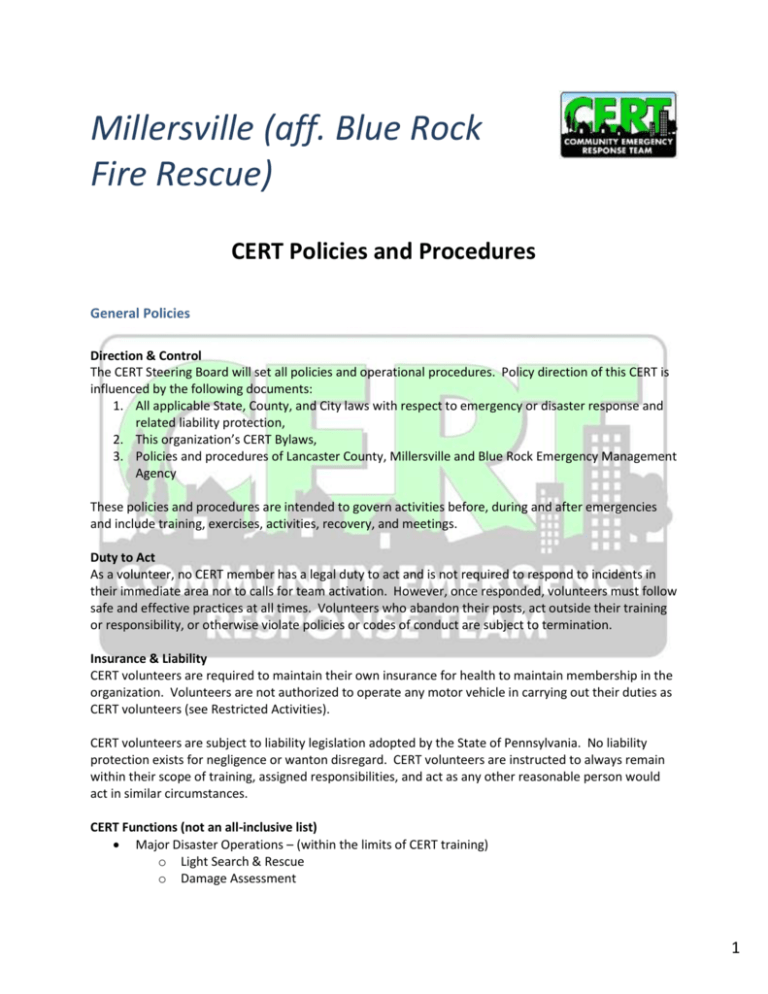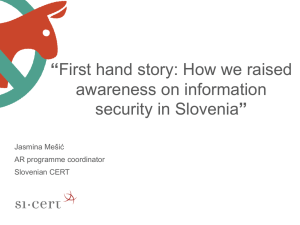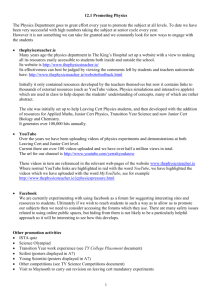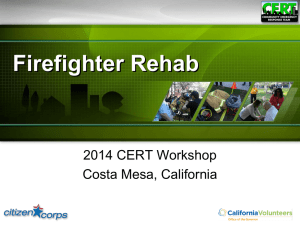General Policies
advertisement

Millersville (aff. Blue Rock Fire Rescue) CERT Policies and Procedures General Policies Direction & Control The CERT Steering Board will set all policies and operational procedures. Policy direction of this CERT is influenced by the following documents: 1. All applicable State, County, and City laws with respect to emergency or disaster response and related liability protection, 2. This organization’s CERT Bylaws, 3. Policies and procedures of Lancaster County, Millersville and Blue Rock Emergency Management Agency These policies and procedures are intended to govern activities before, during and after emergencies and include training, exercises, activities, recovery, and meetings. Duty to Act As a volunteer, no CERT member has a legal duty to act and is not required to respond to incidents in their immediate area nor to calls for team activation. However, once responded, volunteers must follow safe and effective practices at all times. Volunteers who abandon their posts, act outside their training or responsibility, or otherwise violate policies or codes of conduct are subject to termination. Insurance & Liability CERT volunteers are required to maintain their own insurance for health to maintain membership in the organization. Volunteers are not authorized to operate any motor vehicle in carrying out their duties as CERT volunteers (see Restricted Activities). CERT volunteers are subject to liability legislation adopted by the State of Pennsylvania. No liability protection exists for negligence or wanton disregard. CERT volunteers are instructed to always remain within their scope of training, assigned responsibilities, and act as any other reasonable person would act in similar circumstances. CERT Functions (not an all-inclusive list) Major Disaster Operations – (within the limits of CERT training) o Light Search & Rescue o Damage Assessment 1 o o o o o o Light Fire Suppression Logistical Support Disaster Medical Operations Communications and Coordination Documentation EOC Staffing Non Disaster Operations o Training o Exercises o Public education & outreach o Assist partner organization o Service and community projects Training The CERT Basic Training Course, as defined by FEMA curriculum, is the foundation of CERT training and the minimum requirement for membership. Additional training made available to CERT members by partner organizations is intended to increase their awareness, knowledge and abilities, but does not authorize members to work outside their role as CERT volunteers. Membership, training or experience in other organizations does not allow the volunteer to work outside the CERT mission as a CERT volunteer. Public Education & Outreach CERT volunteers are an effective and informative resource in promoting emergency preparedness and public education information. CERT volunteers are encouraged to participate in events, activities and presentations sponsored by the CERT, Citizen Corps Council or partner organization. Equipment All equipment, identification, and materials issued to the CERT volunteer are the property of the Center for Disaster Research & Education and must be returned upon request. CERT volunteers are encouraged to supplement their equipment ensemble with items they feel are useful and appropriate. Equipment that is determined to be outside the scope-of-practice of CERT (firearms, chain saws) are not authorized for inclusion in the volunteer’s equipment bag. CERT volunteers are expected to maintain their equipment in proper working order and to bring the equipment to all necessary training sessions, exercises and incidents. Equipment that is lost, stolen or broken is to be reported immediately to the CERT leadership. Remnants of broken equipment should also be returned. Emergency Response Policies Spontaneous Response The Millersville CERT, affiliation – Blue Rock Emergency Management Agency (EMA), recognizes that a volunteer may find themselves suddenly involved in an emergency that happens in their home, neighborhood, workplace or immediate area, or they may come upon an emergency in the course of normal activities. In such spontaneous incidents, CERT volunteers: 2 Should ensure that emergency response authorities have been contacted with accurate information, Identify themselves as a CERT volunteer to 911 operators and emergency responders when appropriate, May render assistance within their current training and abilities, Shall relinquish command of the scene to proper authorities upon their arrival and may render assistance as requested by incident command. Inappropriate Self-Deployment CERT volunteers are prohibited from self-deploying to routine emergencies in which they are not immediately involved nor requested. Such inappropriate self-deployment is a barrier to proper emergency response and may result in immediate suspension and termination. Activation CERT volunteers may often be notified before specific response needs are determined. This is to enable local authorities the opportunity to assess the resources available, stage and deploy these resources. The Millersville CERT, AFFIL Blue Rock EMA recognizes three levels of activation to be made by the Emergency Operations Center (EOC): Level 1 – Advance Notice This level requires no immediate response action by CERT volunteers. This is an advisory that CERT team leaders have been notified of an emergency management activity which may require CERT assistance. Team leaders will give their members a “heads-up” notice via phone or email and determine the status of all volunteers as “available” or “unavailable”. This information will be forwarded to the EOC contact or notifying official as soon as possible. Level 2 – Alert/Prepare/Standby CERT team leaders and volunteers are to prepare for full deployment within 2 to 4 hours and will remain on standby until notified as an assignment. Upon Level 2 or Standby notification, CERT leaders will contact their volunteers via phone or email to advise them of the pending situation and determine their availability and status. Team leaders will report the status of their team members (who are ready to respond) to the appropriate contact or notifying official as soon as possible. Personal equipment and supplies, vehicles and kits of food, water and clothing should be checked, assembled and packed for deployment. Level 3 – Immediate Deployment Immediate deployment is authorized for CERT volunteers to proceed without delay to their normal assembly point or other area as designated by the EOC. Team leaders will notify all volunteers on their team to deploy and provide a status report of member’s availability back to the appropriate contact or notifying official as soon as possible. Once the team is operational and on-scene, the team leader will notify the appropriate contact or notifying official with an updated status and await further instructions. Team Activation Process and Deployment Protocols 1. Team leaders will be notified by an EOC official to activate their team to Level 1, 2 or 3. If it is not possible for EOC to contact the team leader, the team leader can activate their team in a self-deployment mode. 3 2. Team leader notifies each team member via phone call out tree to meet at their designated meeting location or the incident scene depending on the situation. 3. City and County map coordinates will be used to determine location of emergency scene or incident. 4. Following NIMS training, the first CERT members on scene will select the “on-scene” team leader. 5. Teams do not leave the staging area until adequate resources (Personnel and equipment) are assembled. 6. Establish communications with all team members and ICS command post. 7. Always utilize established protocols and checklists during activation. NIMS and CERT All CERT activities will follow the principles of the National Incident Management System (NIMS) and the Incident Command System (ICS). CERT volunteers will report to the Incident Commander upon arrival and await assignment. All operations will fall within the established command structure and CERT volunteers will report for demobilization following their assignments. When working with authorized responders, CERT volunteers will fall into the ICS system as requested by the Incident Commander. On-Scene CERT Management If a team is deployed and their “primary” team leader and co-leader are not available on scene, the on scene CERT Responders will elect an “on-scene” leader and co-leader with the following responsibilities: On-Scene Leader Duties (unless otherwise delegated) Conduct response planning activities Act as the single point of contact for all communications and coordination between their team members and the Incident Commander or first responders. Size-up situation with assistance from team members and report status to Incident Commander Determine capabilities and limitations of CERT volunteers on scene Organize team and assign tasks to individual team members as they arrive at staging area. Align resources and response activities with incident Commander. Establish Personnel Accountability Reporting (PAR) system. Establish demobilization procedures. Conduct post-incident debriefing for their team. Establish on-scene radio communications capabilities. Check availability of individual member’s equipment. Determine location of team equipment and deploy to scene. Conduct needs assessment for logistics support. Act as team Safety Officer. Collect “Accountability Tags” from each team member as they arrive on scene and ensure tags are returned when member leaves the scene. Maintain personnel logs (member’s time in, assignment and time out of scene) and other resource documentation as required. Ensure all members have a “buddy” assigned. Resource management of team members – rotate and replace personnel. 4 Safety The safety of responders and the general public are of primary importance and all CERT activities must first ensure that additional injuries are avoided. Volunteers shall report all unsafe situations, activities, or practices immediately and take appropriate protective action for themselves and bystanders. Reporting Injuries and Accidents Any activated CERT member who suffers or witnesses an injury while performing an assigned task shall immediately report it to the Incident Commander through ICS. Restricted Activities Many CERT members have skills beyond what is taught through the CERT program (e.g. medical and health professionals, heavy equipment operators, etc.). While these skills may be helpful during an emergency or disaster, and can be utilized in other programs, they are outside of the CERT scope-ofpractice and are not authorized activities as a CERT volunteer. Other unauthorized activities include: Possession or use of a firearm or other weapon Operation of any motor vehicle (private or government) Inappropriate self-deployment to routine emergencies Volunteers found working outside of their CERT mission or engaging in restricted activities or otherwise acting contrary to the code of conduct are subject to immediate removal from the incident and termination. Communications CERT volunteers are encouraged to utilize effective communications procedures, including the use of FRS handheld radios, for ensuring proper communications between team members and with local responders. Documentation CERT team leaders should maintain the following documentation: Current team member contact numbers Preliminary Damage Assessment Form Communication log & Message Forms Personnel Accountability – PAR logs Medical/Triage Log ICS Logs and Forms Credentialing & Identification Vests, ID cards and accountability tags are means of readily identifying CERT volunteers. As with all other issued equipment, these credentialing and accountability tags are property of the Center for Disaster Research & Education. The following policies apply to all current and future credentialing systems used by the CERT. During Spontaneous Response Members are encouraged to wear their vest and other identification as a means of ready identification whenever they act as a CERT volunteer, and when such identification is readily 5 available. Wearing the vest and presenting the ID to responders will help ensure responders are aware of your presence on scene. During Official Activation CERT Responders are required to present current ID badges and Accountability Tags to their team leader or incident commander when responding to an incident. Official CERT vests shall be worn during all CERT activations/events for ready identification during deployments. Helmets are considered protective equipment and are mandatory, along with other protective apparel, in any disaster scene. Members may not wear CERT uniform items (vest/helmet) or display CERT identification unless performing in an official capacity (training, events, deployments, etc.). T-shirts issued to CERT members are not considered official uniform items and may be worn in day to day use. CERT members are encouraged to remember their surroundings and not wear the CERT t-shirt in places that might bring discredit to the CERT organization (see Bylaws-Code of Conduct). Uniform Policy Introduction The appearance of volunteers reflects upon the organization they represent. The wearing of appropriate uniforms enhances the appearance of volunteers and promotes a positive, professional perception of the organization and its personnel. Millersville CERT volunteers are encouraged to wear uniforms at all public events involving Millersville CERT, particularly activations and CERT sponsored events and activities. This policy promulgates expectations and standards concerning uniforms and appearance. CERT personnel are expected to present a neat, clean and well-groomed appearance when conducting operations or when wearing CERT uniform or branded gear in any public setting. Rowlett CERT volunteers shall observe community standards of decorum appropriate to a public service agency at all times. While volunteers may exercise wide latitude concerning clothing and appearance options, there remains a need for guidelines to maintain a reasonable level of uniformity and conformity to standards of appearance. When deployed, uniformity of appearance helps identify CERT volunteer, spontaneous volunteers and onlookers, aiding responding agencies and the general public in determining the status of CERT responders. The appropriate wearing of grade or level insignia aids in identifying leaders and those with advanced training. Appropriate uniforms reinforce the appearance of professionalism, dedication and competence associated with Millersville CERT. Uniform Parts Specific uniforms are not strictly specified by Millersville CERT; however certain items of clothing, particularly CERT or Millersville branded clothing are encouraged. CERT branded clothing is available in a variety of colors and styles. When selecting CERT branded clothing, volunteers are encouraged to seek color and style combinations that enhance the image of Millersville CERT and that present a pleasing appearance. Volunteers are required to observe safety considerations in hazardous operational 6 settings. Non-hazardous operational settings are defined as those settings where an individual is not at risk, or expected to encounter risk of bodily harm during the course of anticipated duties. Anticipated duties include any duty for which CERT volunteers may be assigned during a particular incident. Staffing a booth at a fair or festival is an example of a usually non-hazardous operational setting. A callout for a flood or a search for a missing person is a hazardous operational setting, even if the volunteer is assigned to a relatively safe setting such as the EOC. All volunteers are subject to reassignment to any part of an operational area and are expected to deploy dressed and equipped accordingly. VESTS. Bright yellow reflective ANSI safety vests are authorized. Volunteers are encouraged to wear vests with the word CERT across the back in reflective lettering. Vests are required attire for hazardous operational settings. Vests should be sized to fit over all outerwear, such as winter coats or foul-weather gear. Helmet. An approved hard-hat is required for all hazardous operational settings. Ball Caps. CERT branded ball caps are recommended for deployed operations where helmets are not required, particularly for hot, sunny weather. T-Shirts. CERT branded green T-shirts are recommended for deployed operations wherever safety permits, particularly for hot weather wear. Polo Shirts. CERT branded white polo shirts are recommended for non-operational settings, such as meetings. Oxford-Styled Shirts. CERT branded, CERT green, collared style button shirts are recommended for non-operational settings, such as meetings. Trousers and Shorts. Black, kaki or Navy blue trousers, jeans or shorts are recommended. The choice of long trousers or short trousers (shorts) shall be governed by the context and situation. Most operational settings will require long trousers. Shorts may be appropriate for meetings or non-hazardous operational settings, such as staffing a booth at a festival. Shoes. Boots or shoes shall be appropriate to the context and situation. Boots or closed-toe shoes are required for hazardous operational settings. Open-toed shoes or sandals may be appropriate for meetings or non-hazardous operational settings, such as staffing a booth at a festival. Outerwear. Examples of outerwear include gloves, sweat shirts, wind breakers, coats and foulweather gear. Outerwear shall be appropriate to the prevailing situation, event or context. 7







